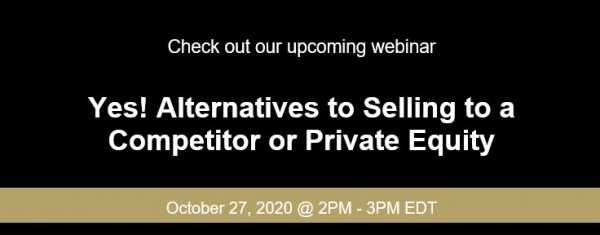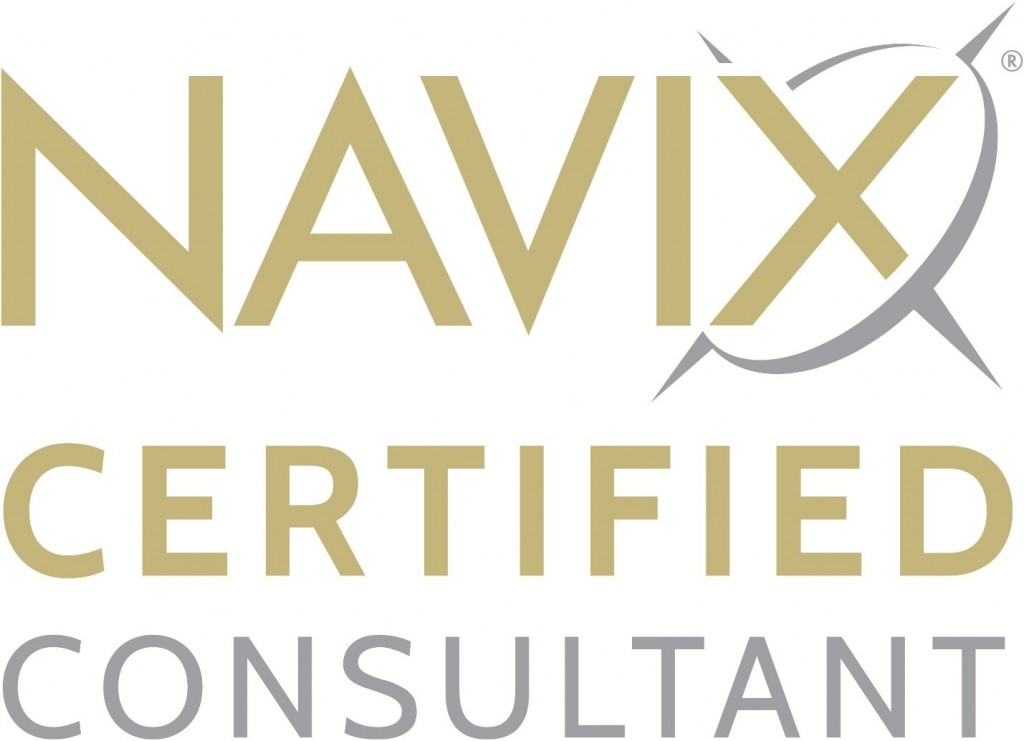
Posts Tagged "Business owner"
Yes! Alternatives to Selling to a Competitor or Private Equity

Perhaps the two biggest myths about selling your company are:
- Your buyer must be a competitor or a private equity firm, and
- When you sell, you must give up control.
Thankfully, neither myth is true.
This educational webinar presents an alternative strategy to achieve the goals that most business owners seek: maximizing personal wealth, maintaining control until you wish to exit, and setting up the company for long-term success.
Register and attend this webinar to learn:
- When it may be right to sell your company to a competitor or private equity group, and when it may be the wrong decision
- How to get cash out of your company without giving up control
- How to position the company for long-term growth and success
Register Now
Contact Tim 772-221-4499, to discuss strategies for your business.
Eight Tactics to Escape the Dark Side of Owner Dependency
By: Patrick Ungashick

In one of the Star Wars movie’s pivotal scenes, Darth Vader attempted to lure his son Luke Skywalker to the dark side of the Force, warning “You don’t know the power of the dark side.” Luke’s skill and talent with the Force made vulnerable to the dark side, and thus the target of his nefarious father’s attention.
There is a powerful lesson here for business owners like you. Your skills and talents may come back to haunt you when you ultimately try to exit from your businesses. Within many companies, the owner is the most valuable and vital employee. Your knowledge, relationships, and vision are what drives the business. Undoubtedly you have help—no CEO/owner build a sustainable business by himself or herself. However, for years or even decades, much of your company growth has mostly been due to your personal presence and efforts. Then, one day, you wish to exit. If at that time you remain an essential employee, you may be unable to achieve commonly held exit goals: financial freedom, a sustained business legacy, and an exit on your own terms. You may find yourself in the dark side, trapped inside the company.
To overcome this, owners must build businesses that are not dependent on them. You must create a business that has the leadership, resources, and plan not merely to survive a transition, but to thrive after you have exited. Reducing owner dependency is, like resisting the dark side’s temptations, easier said than done. Most owners enjoy what they do, and understandably do not wish to become irrelevant within their own companies. Additionally, the company is accustomed to tapping the owner’s talents and skills to the fullest. Yet, as you move closer to exit, owner dependency, if left unaddressed, becomes a serious obstacle to exit success.
Listed below are eight tactics to reduce dependency between now and your future exit.
1.Build a leadership (and/or management) team that can handle day to day operations without you. Ideally, the team can run the company for at least thirty days’ normal operations without your involvement.
2.Collaborate with your leadership to devise and follow a written business growth plan for the next two to three years. Meet periodically during the year to measure performance against the plan’s waypoints and address any lagging results.
3.Conduct leadership team meetings according to a set published schedule. Make sure meetings are run effectively and occur even when you are absent. Meetings should lead to clearly defined and documented decisions.
4.Ensure that the leadership team members have current, written job descriptions and that their job performance is measured against clearly defined and tracked benchmarks.
5.Create a business development team and systems that perform effectively, all the way from lead generation to closing the sale, without your involvement.
6.Verify that your normal daily/weekly duties are either not essential to the business or could be readily filled by other employees cross-trained in those areas.
7.Brief the company’s top employee leaders on your exit goals. These employees must be sufficiently trustworthy for you to share your exit goals in confidence with them. In return, you must create the win-win for them. This can be accomplished using specialized compensation plans to incentivize top leaders to build company value and stay with the organization up to and beyond your exit.
8.Avoid meeting alone with important external relationships, such as customers, prospects, vendors, and lenders. It sends a message that you are the company. If you must participate in these meetings, delegate as much of the conversation as possible to others from your team.
Maximizing Business Value
Creating a company that can survive and thrives without you typically takes several years of focused effort; another reason why preparing for exit must begin no later than five years prior to your intended exit age. The good news is that a company that can operate independently of you is usually a more valuable business if you intend to sell, and a more stable business if you want to exit by way of turning it over to family or employees.
To help, download our popular free ebook: Your Last Five Years: How the Final 60 Months Will Make or Break Your Exit Success. Then, contacts us to schedule a free phone conversation to learn how we have helped hundreds of business owners plan for and achieve a happy exit.
If you have a quick question coming out of this article or, if you want to discuss your situation in more detail, we can set up a confidential and complimentary phone consultation at your convenience contact Tim 772-221-4499,

Why Your Company’s Profitability is Not the Same as Exitability
By: Patrick Ungashick

It’s not difficult to evaluate your company’s profitability—it’s right there, in black and white, in the financial statements. This clarity is beneficial, because company profitability is arguably the single most critical area of business performance. As the saying goes, revenue is vanity but profits are reality. So when you one day want to exit, the more profitable your business, then likely the more valuable it will be at your exit.
But just because your company is profitable, does that mean it is exitable? Admittedly, I made up the word “exitable,” but for a good reason. An exitable company is one that is well prepared for the owner to exit and will fulfill the owner’s business and personal exit goals. Many companies are profitable but not exitable. If your company has any characteristics that limit its exitabilty, when you go to exit you will find the path more difficult than you expected, the company less valuable than you desired, or at worst your exit completely blocked. Moreover, if you only find out all these issues right when you want to exit, it will be too late to do anything about it.
Profitability and exitability are not the same. There are a surprising number of ways that businesses can grow and operate profitably, without necessarily being exitable. Here are four common situations where this can occur:
Owner Dependency
The first common limitation on exitability is owner dependency. If your business is dependent on you, or any other owners, to operate and grow profitably, this typically limits exitability. The company’s value cannot walk out the door when you do. It’s also ironic because your company probably would not be what it is today if you had not worked as hard as you have up to now, perhaps over many years. It’s great to be good at what you do, but if your company is losing an essential employee when you exit, that undermines exitability. It’s not enough either to say that the company could manage to survive without you. It has to be able to thrive without you. Buyers want to know that the business’s profits will not slow down nor go away when you do.
Customer Concentration
The second common limitation on exitability is customer concentration. This statement may surprise you because customer concentration is usually a byproduct of a job well done. Your company may have served one or a few customers well, and they’ve responded by sending more and more business your way. Then, one day, you look around, and 20%, 30%, 50%, or more of your revenue and profits comes from these few customers. These customers might be generating many profits, but customer concentration usually limits exitability. If you intend to sell your company one day, your future buyers likely won’t have longstanding relationships with these customers, creating risk for them. Buyers often pay less for companies with customer concentration or pass on purchasing that company altogether. Customer concentration thus becomes a serious limitation on exitability, no matter how profitable those customers may be.
Co-Owner Goal Misalignment
The third way many companies experience limited exitability is if they have co-owners who are not in alignment with one another. We did a research study a number of years ago and it revealed that 7 out of 10 small to medium-sized privately-owned companies have ownership shared among two or more co-owners. We often see co-owners who are in strong alignment with one another for years and sometimes even decades while they are working together to grow the business because they share one clear priority, which is to increase revenues and profits. The problem arises when one or more of those co-owners get closer to exit because the goals often change and the co-owners find themselves no longer in alignment. For example, one co-owner may want to sell now, while another wants to wait. Alternatively, one co-owner may wish to sell for a lower price, while another wants to keep growing the company and hold out for a higher price. Whatever the situation, when the goals change, the co-owner alignment changes, and often the co-owners don’t even realize it’s happening until close to exit, at which point it can completely undermine a company’s exitability. No matter how profitable your company may be, if the co-owners are not in alignment, exitability will suffer.
Unclear Plan for the Future
The fourth way companies experience reduced exitability, regardless of profitability, occurs if the company lacks a clear, compelling plan for future growth. For a company to be highly exitable, it must offer a buyer or successor a credible and compelling vision for how that company will grow going forward, after your exit. How profitable the company has been up to this point is nice, but what the company is expected to do in the future drives value and exitability.
Many profitable companies don’t have the systems and habits that help create this compelling plan for future growth. For example, the company leadership team might not do robust strategic planning, or perhaps they do not diligently measure monthly or quarterly performance against financial budgets and operational benchmarks. Without experience doing effective strategic planning, and without a clear track record of being accountable for achieving business goals, it may be unclear to the future buyer or successor whether or not this company can sustain its future growth after your exit. This lack of management practices undermines exitability, even if the profitability has historically been excellent.
Conclusion
These are just four situations that can limit a company’s exitability—and they are prevailing. Growing profits, and getting a company ready for exit, are two different needs. To learn more about preparing your company for exit, consider this educational webinar or contact us with your exit planning questions.
If you have a quick question coming out of this article or, if you want to discuss your situation in more detail, we can set up a confidential and complimentary phone consultation at your convenience contact Tim 772-221-4499

Why a Buyer’s Motives Determine Your Company’s Multiple
By: Patrick Ungashick

“What will my company be worth at sale?” is perhaps one of the most common questions business owners ask when contemplating their exit. It’s not only owners who expect to sell their company to an outside buyer ask either. If you intend to sell your business to your employees, you still need to know the answer to this question. Even if you want to give your business to your kids, this question is essential to plan for taxes and other financial issues. Regardless of which of the four exit strategies you intend to implement, you need to know what your company is likely worth to an outside buyer.
That’s where the problem occurs. How do you know what a buyer might pay for your company when typically there are multiple potential buyers? You can and should research average company sale prices in your industry (usually expressed as a multiple of adjusted EBITDA (LINK) or in some cases revenue)—if you don’t know these benchmarks you are operating blindly. However, this information only tells you what other companies have been selling for. It does not specifically address what YOUR company may sell for. Even more frustratingly, you may have heard stories from other business owners (or your advisors) about how they got wildly different offers when their companies went up for sale. Why does that happen?
Different Buyers = Different Motives
When you go to sell your company, typically you and your advisors will follow a process that confidentially contacts many potential buyers (often dozens to even a few hundred) to solicit inquiries and offers to purchase the company. The one thing that all of these potential buyers have in common is they are seeking ways to grow their businesses, and perhaps an acquisition of your company will help them drive their growth. Also, while they share the same desire to drive growth, these buyers are different from each other. They are in different situations, have different needs, and face different internal and external challenges. These differences manifest into different motives from one potential buyer to the next. Furthermore, these different motives likely translate into different multiples one buyer may pay for your company compared to another.
For example, here are some of the common motives that cause different potential buyers to be more (or less) interested in buying a company:
- Geographic expansion: the buyer lacks operations or presence in your location and sees acquiring your company as a means to launch in your territory.
- Diversification and Cross-Selling: the buyer wants access to the products and services that your company has, to complement its existing products and services.
- Market Share / Client Acquisition: the buyer seeks to increase its market share, scale, and/or profitability by acquiring your customers and clients and adding them to its platform.
- Talent Acquisition: the buyer seeks to expand its team by acquiring your company and the proven talent that you have assembled.
- Technology Acquisition: the buyer wants key technology that you have developed to leverage across its operations to open new markets, reduce its costs, embed in its services, etc.
- Competition Elimination: the buyer wants to acquire your company to remove it as a competitor, or to prevent another competitor from buying your business.
While any buyer may have all of these motives to some degree, typically each buyer will have one or perhaps two over-riding reasons that drive its interest in acquiring your business—and the price it is willing to pay. Different buyer motives translate into different prices.
That is why if you and your advisors run an effective process which attracts multiple qualified buyers, you are likely to experience a diverse range of bids. In our experience, it is common that the range between the lowest and highest offers is two to three times more or greater.
For example, assume your company is doing $3 million adjusted EBITDA (link). After marketing your company to multiple potential buyers, you receive the following bids:
- Buyer A – offers to pay $15 million for your company (5 times EBITDA)
- Buyer B – offers to pay $30 million for your company (10 times EBITDA)
- Buyer C – after initially seeming very interested, this buyer withdraws from the process without making an offer
On the surface, it would look like either Buyer A or Buyer B should go back to grade school to learn basic math, because how can one buyer offer five times EBITDA while another offers twice that amount? Furthermore, what’s wrong with Buyer C because it seems they think your company is worthless. While no buyer is perfect and all buyers make mistakes, the more likely explanation is these three buyers have different motives in mind while evaluating your company, and these mixed motives translate into different multiples they are willing to pay.
What’s Important for You and Your Company
If different potential buyers all valued a business solely based on that company’s multiples of adjusted EBITDA, then all offers would be relatively similar. However, in the real world, this does not happen. Different buyers have different motives and pay different multiples.
Don’t fall into the trap of trying to anticipate one buyer’s motives over another’s, because it is nearly impossible to know a buyer’s internal dynamics, and motives change with time. Instead, focus on getting your company ready for exit and then be prepared to experience different motives producing different multiples. To learn more, watch this helpful webinar with several real case studies, and suggested tactics for you to follow.
If you have a quick question coming out of this article or, if you want to discuss your situation in more detail, we can set up a confidential and complimentary phone consultation at your convenience contact Tim 772-221-4499

Case Study: Larry Legacy Takes a Lesser Offer

This short case study tells the real story of a business owner who intentionally sold his business for millions of dollars less than what he could have received — and why he did it. The key insight that this case study offers is “legacy vetoes price.” (Note: The names and some of the details have been changed and noted with an asterisk* to honor this former client’s confidentiality.)
By: Patrick Ungashick
Larry* never wanted to lead the biggest electrical contracting firm when he first opened his doors, but he did want to be one of the best.
He wanted customers to get great service. He wanted employees to be treated well and to have good jobs. He wanted a company that he could be proud of and for which others would be proud to work.
And he succeeded. For 20 years, he ran a fine company that met or exceeded all of his hopes and plans.
All was good.
Until the doctors told him he had perhaps a year to live and would never see his 50th birthday.
The cancer was inoperable and untreatable.
Preparing for a Quick Sell
That’s when Larry contacted us for help expediting his exit plans. Larry wanted to spend his remaining time with family. He also wanted to get maximum value for his company to ensure that his family would be financially secure despite losing him at a young age and despite facing significant medical costs in the months ahead. Larry wanted to sell as quickly and for as high a price as possible.
Many potential buyers were contacted, and after months of work, Larry had two competitive offers from qualified buyers from which to choose. Offer #1 was for $18 million*. Offer #2 was for $14 million*. Both offers would allow him to make a quick transition, freeing up time to spend with his family and address his medical care. Both offers were all-cash deals.
Larry reviewed the offers with us, his other advisors, and with his family. He took a few days to think about his decision and, as a devout man of faith, undoubtedly prayed for guidance as well.
Then he accepted the lower offer of $14 million and sold his company.
Choosing to Turn Down an Extra $4 Million
Why would anybody in his situation walk away from an extra $4 million? Why would any business owner, regardless of health, age, or any other circumstances, voluntarily relinquish that much cash? Not to be callous, but was Larry’s battle with his health interfering with his decision-making?
Larry was perfectly sound and sane when he took the lesser offer. Larry’s medical situation may have been unusual and unplanned, but his decision to take the lesser offer is not unusual. For Larry, legacy vetoed price. Larry had an additional set of concerns and objectives that he wanted to achieve when he exited from his company, beyond selling for the highest price.
As the sale of his company drew near, Larry realized — like many owners do — that he strongly preferred to sell his company to a buyer that would treat his team and customers well. Larry cared deeply that his company’s reputation and values remain untarnished during and after his exit process. When it came time for Larry to choose between his two qualified offers, these other concerns were powerful enough that they could veto a higher sale price.
Of the two offers Larry had to choose from, he knew both buyers by name and by reputation. The buyer making the higher ($18 million) offer was a local company. He strongly suspected that this buyer would let go many of his people and close down his facilities. He felt his customers would not be treated by this buyer in a manner consistent with his values.
Larry also knew a bit about the company making the lesser ($14 million) offer, too. As an out-of-town competitor, he believed this buyer would keep Larry’s local team and operations largely intact and that this buyer would treat customers in a manner consistent with his high standards.
Larry was pragmatic enough to know that he could not guarantee anybody’s jobs nor control the future of his company after he sold it, but Larry strongly believed that he should at least hand off his business to people who would govern it in a similar fashion.
Valuing Legacy Above Sale Price
Larry’s decision was not an easy one. He had us crunch the financial models a dozen different ways to make sure that his family would still be secure if he sold his business for the lower price. (Ask us more about how to do this.) He demanded that we challenge his thinking and play devil’s advocate. But, in the end, he took the lesser offer because legacy can and does veto price.
Larry would not have been mistaken or unjustified in taking the higher offer. Neither his family nor his employees would have faulted him if he had done so. And, in our experience, many owners do take the higher price with a justifiably clear conscience.
But the lesson that Larry’s experience can teach all of us is that legacy concerns, such as whose hands you leave it in, are sufficiently powerful to outweigh a higher sale price.
Answers to your questions:
To learn more about the steps necessary for a successful exit, contact Tim for a complimentary consultation: 772-221-4499 or email.

Putting Golden Handcuffs on Key Employees: Where would your business be without your most valuable people?
3 Financial Needs Business Owners Must Address to Exit Happily
The number one goal most business owners wish to achieve at exit is to reach personal financial freedom. (We define financial freedom as reaching a point where working is a personal choice, not an economic necessity.)

While everybody’s dollar amount is different, reaching financial freedom is practically a universally-held goal. To have a good chance of reaching this goal, it is not enough to merely calculate the target number you need at exit.
Most owners have three distinct needs they must meet to attain and maintain a financially happy life at exit and beyond. Fail to address any of these needs, and you may not be able to exit happily. Or, you might exit only to realize somewhere down the road that you regret the decision.
Here are the three needs you must address to reach and maintain your financial goals:
#1 – Replace Earned Income
The first need is to replace earned income. After you exit, you will need to replace the income previously earned from your business with investment income sufficient to support your personal lifestyle. This need may seem straightforward, but owners are often surprised by the challenges involved.
It is not unusual that your business generates a higher level of annual income than a prudently-invested portfolio can produce. Assume you enjoy an annual income of $X amount from the company, but your financial planning and forecasts indicate that, after you exit, your investment portfolio will only generate an annual income of less than $X. That is not exciting to contemplate.
Taxes often worsen the picture. If you sell your company at exit, you likely have to pay a significant amount of unrealized taxes at that time. This tax bill erodes how much you have to invest after exit, further reducing the income stream.
Furthermore, most owners enjoy a portion of their lifestyle subsidized by their business. The business pays for some (or all) of the following: vehicles, cell phones, computer, meals, travel, insurance, taxes, etc. These company-paid expenses shift to personal expenses at exit, thus increasing the amount of personal income required after exit to maintain the desired standard of living.
Ultimately, if you cannot replace the income you receive from your business with a reliable stream of income from your investments post-exit, you may find yourself trapped in the company and unable to afford to exit.
#2 – Transition from Running a Company to Running a Portfolio
The second need is less obvious but no less important for your exit happiness — you will need to make the transition from running a business to running a portfolio. There are certain skills and tactics that made you a successful business owner, and these may not be the same skills and tactics needed for investment portfolio management.
Being a successful business owner does not necessarily translate into being a successful investor. For example, successful investing often involves patience, taking a disciplined approach, and not reacting too quickly when investment markets fluctuate in short-term movements.
However, being a successful business owner and entrepreneur often demands that you be willing to react quickly to market opportunities as they present themselves. You will not feel financially secure as long as you are uncomfortable or unprepared with the steps and tactics required to manage your post-exit portfolio most effectively, regardless of how large it may be.
#3 – Manage Pre-Exit Risks
The third need is to manage ownership risk before your actual exit. Many owners do not consider their company to be a risky asset because they lead it and largely control its activities. But if you are like most owners, then prior to exit, 50%-90% of your net worth is tied up in your company.
It is undeniable that having the majority of one’s net worth tied up in any asset creates risk. If something happens to you or your company prior to exit, your future financial freedom is at risk. For example, imagine you own three assets:
- A piece of real estate worth $5 million
- Cash account with $5 million
- A company worth $5 million
All three assets are equally worth $5 million, yet the risks associated with owning the company are different and higher. If you became seriously ill or died prematurely, the real estate and cash likely maintain their value, but your company’s value may suffer a severe reduction without you.
The same risk exists if something happens to your company rather than you. If a large customer leaves your company, the cash and real estate will still be worth the same amount, but the company value may depreciate. Therefore, to reach financial freedom at exit, you must take the proper steps to address the inherent risks that come with owning a company. After all, you only have one shot at exit success.
Reaching Financial Freedom
These three needs will help you understand the to-do-list as you migrate from current business owner to investor. You are beginning a major life transition. Up to this point, your primary source of income has been your business, and as the owner, you have been in a position to call the shots.
But you only have one shot at exit success, so you need to get it right. As the saying goes, “You can get rich by investing in one company, but you can’t stay rich that way.”
What to Do Next
The most important next step is to sit down with experienced advisors, clearly define your financial and other exit goals, and develop the plan that will achieve those goals. To learn more about the steps necessary for a successful exit, contact Tim for a complimentary consultation: 772-221-4499 or email.

Own a Majority of Your Company and Think You’re in Control? Think Again.
If you share ownership of your company but personally have at least 50%, you are probably used to being in control. On issues like company strategy, money, and people, you have the final say. But what about when it comes to exiting from your company? For example, what if you want to sell the business, but one or more minority co-owners do not want to sell? Are you still in control? Probably not. Here’s why.
We routinely say in the U.S. “It’s a free country.” One freedom is the right to own property. Within this right generally, one person cannot force another person to part with property that he or she owns. If you don’t want to sell your car, home, or shares of Apple Computer stock, then nobody can make you. The same principle applies within your company. If you wish to exit by way of sale, but one or more minority co-owners don’t want to sell, typically you cannot make them sell their portion of your company. If a minority co-owner does not want to sell, then you might not be able to sell either. Most buyers will not want to acquire your majority interest in the company if the purchase comes with one or more unknown minority partners, especially people opposed to the sale. Practically speaking, minority co-owners can veto a sale, leaving you not in control of your own exit.
This reality often comes as an unwelcome surprise to majority owners seeking to exit. Some owners only learn their minority partners can block a sale when a potential buyer is standing in the doorway. Should this occur, your only options are trying to talk your minority partners out of their objections, offering to buy them out at an even higher price, or seeking legal action if you and your lawyers can find sufficient grounds. None of these are attractive options. The company sale would be in jeopardy, and the relationship with your co-owners may suffer irreparable harm.
To regain control over your exit, and to avoid a future impasse with your co-owners, take the following two important steps:
Step One: Talk About Exit – Now
Many business co-owners do not have open, detailed conversations about their business exit goals and plans. It’s not hard to see why. The company keeps you busy, and planning for exit may not be on the priority list for most days. But co-owners cannot afford to wait to have these necessary conversations to determine if their exit goals are in alignment or in conflict. The more time you give yourselves to work out any exit goal misalignment, the more options you have. Also, you never know when a buyer might come along—if you wait until a buyer is standing there to have your first exit conversations, it will be too late.
To help co-owners get started, download our free eBook called The Guide to Creating Co-Owner Alignment.
Step Two: Put It in Writing – Now
Once co-owners start having the difficult but necessary exit conversations, they discover the advantages of implementing written agreements that govern how ownership may change hands, such as upon the sale of the company. One common type is a buy-sell agreement. Buy-sell agreements are legal documents that identify situations where ownership in the company may change hands and provide instructions on how each situation is to be handled. The most familiar example is what happens upon the death of a co-owner. A buy-sell agreement usually requires the deceased owner’s heirs to sell the interest back to the company or the surviving owner(s) and at a specified price. This protects everybody: the deceased owner’s heirs receive a cash payout while the remaining owner(s) move forward without unwanted business partners.
Buy-sell agreements nearly always address the death scenario, and most address other contingencies such as if a co-owner becomes seriously ill or disabled. However, few buy-sell agreements govern how co-owners must handle an offer to sell the entire company. This omission leaves business co-owners at risk. To fill in the gaps, ask your legal advisors about including “drag-along” and “tag-along” rights within your buy-sell agreement. These odd-sounding provisions bind co-owners together when selling the business to an outside buyer. The “drag-along” part requires that if the majority co-owner sells his or her stake in the business, the minority co-owners are required to join the deal.
To fill in the gaps, ask your legal advisors about including both “drag-along” and “tag-along” rights within your buy-sell agreement.
This protects majority co-owners against minority co-owners holding up a sale. “Tag-along” is the reverse—the majority co-owner cannot sell his or her stake without the minority owners tagging along and being included at the same price and terms. This protects minority co-owners from being left out of any deal. Together, these provisions bind all the co-owners into a single block and restore the majority owner’s control over the decision to sell the entire business.
Making sure you are in control of your own exit is critically important. At NAVIX, our clients – even those who share ownership of their company — are prepared for multiple exit scenarios, and NAVIX works with our clients to ensure they have agreements in place to mitigate against one minority owner holding up a sale. To learn more about these exit planning steps, contact us to schedule a complimentary, confidential consultation with one of our independent NAVIX Consultants.
To discuss your unique business, and how to plan for and achieve a successful exit, Call 772-210-4499 or email Tim to schedule a confidential, complimentary consultation.



 Tim is a Consultant to Business, Government and Not-for-Profits Organizations specializing in innovative and challenging ways for organizations to survive, to thrive and to build their teams.
Tim is a Consultant to Business, Government and Not-for-Profits Organizations specializing in innovative and challenging ways for organizations to survive, to thrive and to build their teams.